Strategic Management Report: Lego Company Analysis and Strategies
VerifiedAdded on 2020/01/23
|16
|4383
|218
Report
AI Summary
This report provides a comprehensive strategic analysis of the Lego company. It begins with an introduction to strategic management and an overview of Lego's history, highlighting its evolution from wooden toys to plastic products. The case analysis section employs a structured approach, including framing, labeling, summarizing, synthesizing, and concluding, to dissect the challenges Lego faces, such as financial fluctuations, competition, and the need for innovation. The report identifies key questions, such as how to achieve growth, incorporate technology, and maintain a competitive edge. It analyzes the company's strengths and weaknesses, market position within the toy industry, and the impact of external factors like political, environmental, social, technological, economic, and legal environments. The report utilizes models like the Triple Bottom Line and Mintzberg's 5 Ps to evaluate Lego's corporate social responsibility and strategic decision-making. The analysis covers various aspects, including product development, management issues, and the impact of the online gaming market, ultimately aiming to identify strategies for long-term profitability and competitive advantage.
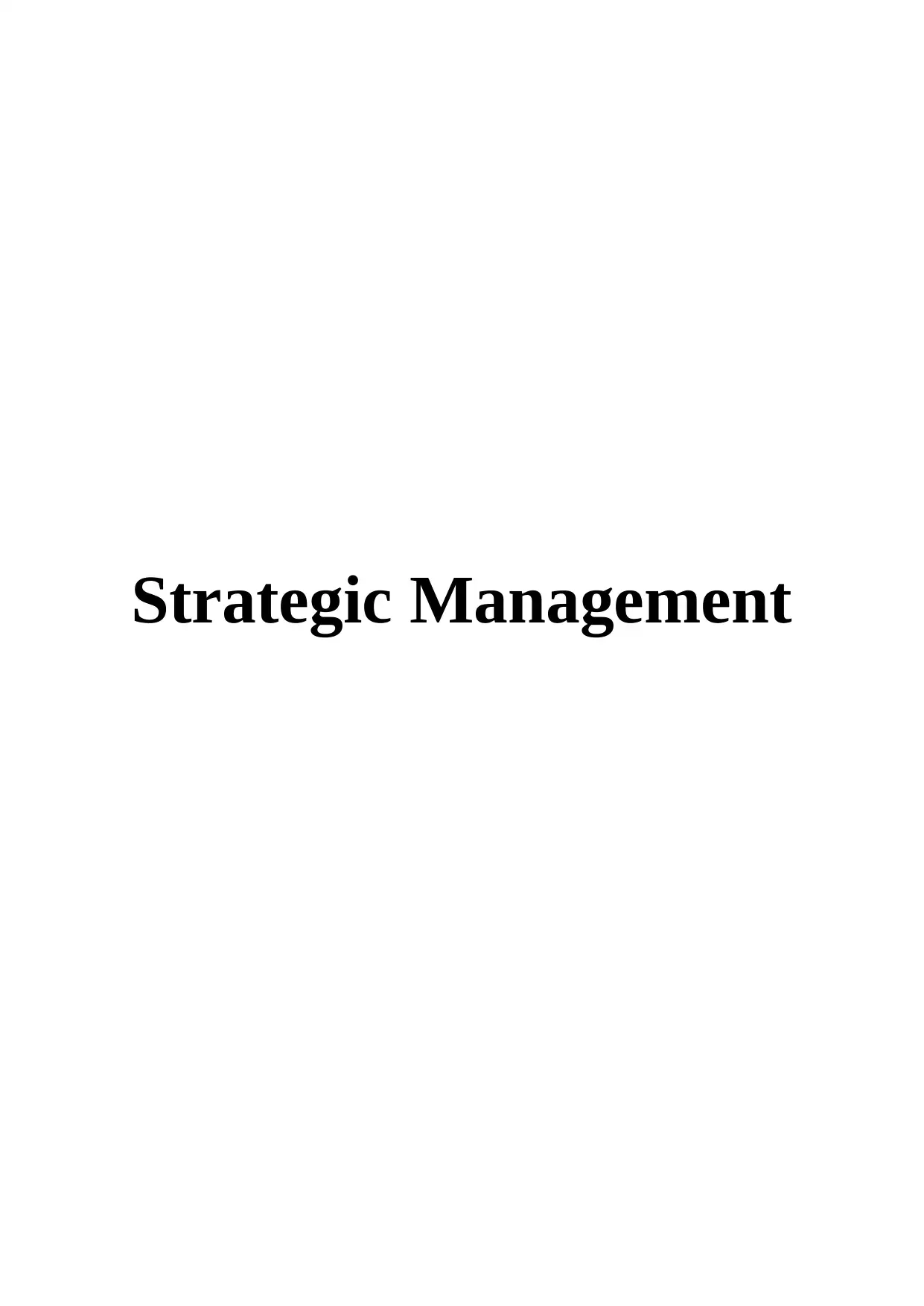
Strategic Management
Paraphrase This Document
Need a fresh take? Get an instant paraphrase of this document with our AI Paraphraser

Table of Contents
INTRODUCTION................................................................................................................................3
CASE ANALYSIS ...............................................................................................................................3
Phase 1: Framing.............................................................................................................................3
Phase 2: Labelling............................................................................................................................5
Phase 3: Summarising......................................................................................................................7
Phase 4: Synthesizing......................................................................................................................9
Phase 5: Concluding......................................................................................................................11
CONCLUSION..................................................................................................................................12
INTRODUCTION................................................................................................................................3
CASE ANALYSIS ...............................................................................................................................3
Phase 1: Framing.............................................................................................................................3
Phase 2: Labelling............................................................................................................................5
Phase 3: Summarising......................................................................................................................7
Phase 4: Synthesizing......................................................................................................................9
Phase 5: Concluding......................................................................................................................11
CONCLUSION..................................................................................................................................12
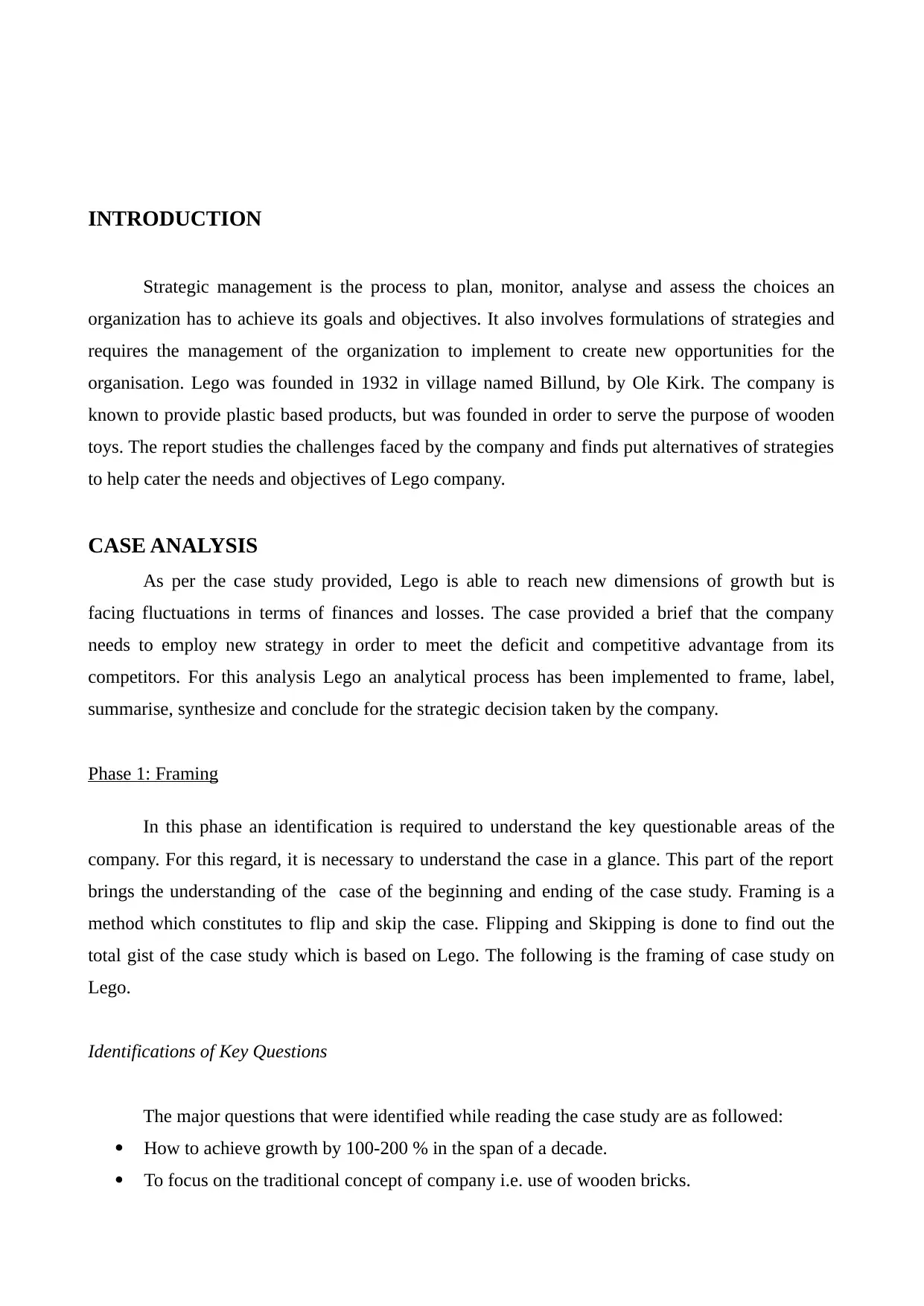
INTRODUCTION
Strategic management is the process to plan, monitor, analyse and assess the choices an
organization has to achieve its goals and objectives. It also involves formulations of strategies and
requires the management of the organization to implement to create new opportunities for the
organisation. Lego was founded in 1932 in village named Billund, by Ole Kirk. The company is
known to provide plastic based products, but was founded in order to serve the purpose of wooden
toys. The report studies the challenges faced by the company and finds put alternatives of strategies
to help cater the needs and objectives of Lego company.
CASE ANALYSIS
As per the case study provided, Lego is able to reach new dimensions of growth but is
facing fluctuations in terms of finances and losses. The case provided a brief that the company
needs to employ new strategy in order to meet the deficit and competitive advantage from its
competitors. For this analysis Lego an analytical process has been implemented to frame, label,
summarise, synthesize and conclude for the strategic decision taken by the company.
Phase 1: Framing
In this phase an identification is required to understand the key questionable areas of the
company. For this regard, it is necessary to understand the case in a glance. This part of the report
brings the understanding of the case of the beginning and ending of the case study. Framing is a
method which constitutes to flip and skip the case. Flipping and Skipping is done to find out the
total gist of the case study which is based on Lego. The following is the framing of case study on
Lego.
Identifications of Key Questions
The major questions that were identified while reading the case study are as followed:
How to achieve growth by 100-200 % in the span of a decade.
To focus on the traditional concept of company i.e. use of wooden bricks.
Strategic management is the process to plan, monitor, analyse and assess the choices an
organization has to achieve its goals and objectives. It also involves formulations of strategies and
requires the management of the organization to implement to create new opportunities for the
organisation. Lego was founded in 1932 in village named Billund, by Ole Kirk. The company is
known to provide plastic based products, but was founded in order to serve the purpose of wooden
toys. The report studies the challenges faced by the company and finds put alternatives of strategies
to help cater the needs and objectives of Lego company.
CASE ANALYSIS
As per the case study provided, Lego is able to reach new dimensions of growth but is
facing fluctuations in terms of finances and losses. The case provided a brief that the company
needs to employ new strategy in order to meet the deficit and competitive advantage from its
competitors. For this analysis Lego an analytical process has been implemented to frame, label,
summarise, synthesize and conclude for the strategic decision taken by the company.
Phase 1: Framing
In this phase an identification is required to understand the key questionable areas of the
company. For this regard, it is necessary to understand the case in a glance. This part of the report
brings the understanding of the case of the beginning and ending of the case study. Framing is a
method which constitutes to flip and skip the case. Flipping and Skipping is done to find out the
total gist of the case study which is based on Lego. The following is the framing of case study on
Lego.
Identifications of Key Questions
The major questions that were identified while reading the case study are as followed:
How to achieve growth by 100-200 % in the span of a decade.
To focus on the traditional concept of company i.e. use of wooden bricks.
⊘ This is a preview!⊘
Do you want full access?
Subscribe today to unlock all pages.

Trusted by 1+ million students worldwide

Or to focus in generating innovations.
How to incorporate technological advancements in the traditional concept of the company.
How to achieve strong positions over competitors like Mattel, Hasbro, Sony, Nintendo and
etc.
How to deal with the losses and huge deficit issues faced by the company.
How to manage new adoptions in formations of strategy.
How to maintain long term planning and profitability
How to manage the short term fluctuations faced in different departments like management,
IT, operation's and retaining of experienced employees.
Flipping and skipping the case
Lego was founded in order to serve its customers with the traditional ironing boards,
stepladders, stools and wooden toys. In 1949, the company decide to switch to the better options of
plastic available in the market. Thus led to the rise of Lego plastic products, which were at first new
for the public to adopt but soon it became popular in the market. The case, basically discusses the
various issues faced by the company over the period of its incorporation. From facing
environmental issues, oil crisis, management issues, employee retention, deficits and losses,
building brand image of the company and managing to build competitive advantage in the market.
The company over and over again faced new challenges and always come out of victory. This is due
the strategic management policies adopted by the CEO, Kjeld Christiansen over the period of time.
Although the company had to face criticism of its new strategic choices which led to departure of
capable employees it soon recruited new talent to support the requirements of its offices on the
global basis. The company also had to face many downsides through heavy losses that accounted to
1 Billion DKK in years 1998, 2000 and 2003. The company also expanded globally, and introduced
new products theme with co-operation with movie giants like Harry Potter and Star Wars.
The Beginning
In the beginning of the case study, the influence of family business is very much prevalent.
The toy manufacturing company tried to bring in many innovations in terms of product
development to attract customers to buy their products. The companies earlier objective was to
serve to the traditional needs of its customers. But it soon realised to expand and tried to increase its
customer base in the international market. The company was highly influential and was very
popular among its customer base. Lego soon faced backlash and lost its brand image due to heavy
How to incorporate technological advancements in the traditional concept of the company.
How to achieve strong positions over competitors like Mattel, Hasbro, Sony, Nintendo and
etc.
How to deal with the losses and huge deficit issues faced by the company.
How to manage new adoptions in formations of strategy.
How to maintain long term planning and profitability
How to manage the short term fluctuations faced in different departments like management,
IT, operation's and retaining of experienced employees.
Flipping and skipping the case
Lego was founded in order to serve its customers with the traditional ironing boards,
stepladders, stools and wooden toys. In 1949, the company decide to switch to the better options of
plastic available in the market. Thus led to the rise of Lego plastic products, which were at first new
for the public to adopt but soon it became popular in the market. The case, basically discusses the
various issues faced by the company over the period of its incorporation. From facing
environmental issues, oil crisis, management issues, employee retention, deficits and losses,
building brand image of the company and managing to build competitive advantage in the market.
The company over and over again faced new challenges and always come out of victory. This is due
the strategic management policies adopted by the CEO, Kjeld Christiansen over the period of time.
Although the company had to face criticism of its new strategic choices which led to departure of
capable employees it soon recruited new talent to support the requirements of its offices on the
global basis. The company also had to face many downsides through heavy losses that accounted to
1 Billion DKK in years 1998, 2000 and 2003. The company also expanded globally, and introduced
new products theme with co-operation with movie giants like Harry Potter and Star Wars.
The Beginning
In the beginning of the case study, the influence of family business is very much prevalent.
The toy manufacturing company tried to bring in many innovations in terms of product
development to attract customers to buy their products. The companies earlier objective was to
serve to the traditional needs of its customers. But it soon realised to expand and tried to increase its
customer base in the international market. The company was highly influential and was very
popular among its customer base. Lego soon faced backlash and lost its brand image due to heavy
Paraphrase This Document
Need a fresh take? Get an instant paraphrase of this document with our AI Paraphraser

losses and changes in the management of the company. The toy manufacturing company decided to
employee strategies that led to the expansion prospect of the company. It decided to become the
best known brand among its customers by increasing sales and employing more Legoland parks.
The company also decided to enhance its product appeal through engagement with alliances like
films, games and clothing. Due to this 1995-1997 accounted to be the most profitable year for the
company. With raising appreciations and demand Lego soon fell for the losses and deficits.
The Ending
With the hiring of new COO, company faced an environment that led to various turnaround
situations. Almost 1000 employees were laid off, and a fitness programme was regulated that
initiated cost cutting in the organisation. The company was routing for the long term profitable
issues but faced failed to achieve milestone on short tern basis. In 1999, company launched a new
Legoland park in California and Starwars themed products. Whereas in 2000 it saw a decline in its
sales and soon fall back to losses amounting to 1 Billion. The company tried its best to come back
on the track but failed many times which resulted to heavy deficits. Finally the company decided to
employ new strategic measures to liberate the issues and challenges faced by the company. The
company required to evaluate various issues mainly which were as follows.
Increase its capital structure
Product development issues
Problems of high inventories
Less innovation
High competition
Impact of economic policies
Retention of employees.
Soon to evaluate the company identified new measures which led to development of
strategies like, change in the management style, improving relationship with the employees, cost
reduction, generating innovation through digital sources and etc. Thus finally company understood
that it had to meet long term objectives by tackling the short term fluctuations.
employee strategies that led to the expansion prospect of the company. It decided to become the
best known brand among its customers by increasing sales and employing more Legoland parks.
The company also decided to enhance its product appeal through engagement with alliances like
films, games and clothing. Due to this 1995-1997 accounted to be the most profitable year for the
company. With raising appreciations and demand Lego soon fell for the losses and deficits.
The Ending
With the hiring of new COO, company faced an environment that led to various turnaround
situations. Almost 1000 employees were laid off, and a fitness programme was regulated that
initiated cost cutting in the organisation. The company was routing for the long term profitable
issues but faced failed to achieve milestone on short tern basis. In 1999, company launched a new
Legoland park in California and Starwars themed products. Whereas in 2000 it saw a decline in its
sales and soon fall back to losses amounting to 1 Billion. The company tried its best to come back
on the track but failed many times which resulted to heavy deficits. Finally the company decided to
employ new strategic measures to liberate the issues and challenges faced by the company. The
company required to evaluate various issues mainly which were as follows.
Increase its capital structure
Product development issues
Problems of high inventories
Less innovation
High competition
Impact of economic policies
Retention of employees.
Soon to evaluate the company identified new measures which led to development of
strategies like, change in the management style, improving relationship with the employees, cost
reduction, generating innovation through digital sources and etc. Thus finally company understood
that it had to meet long term objectives by tackling the short term fluctuations.
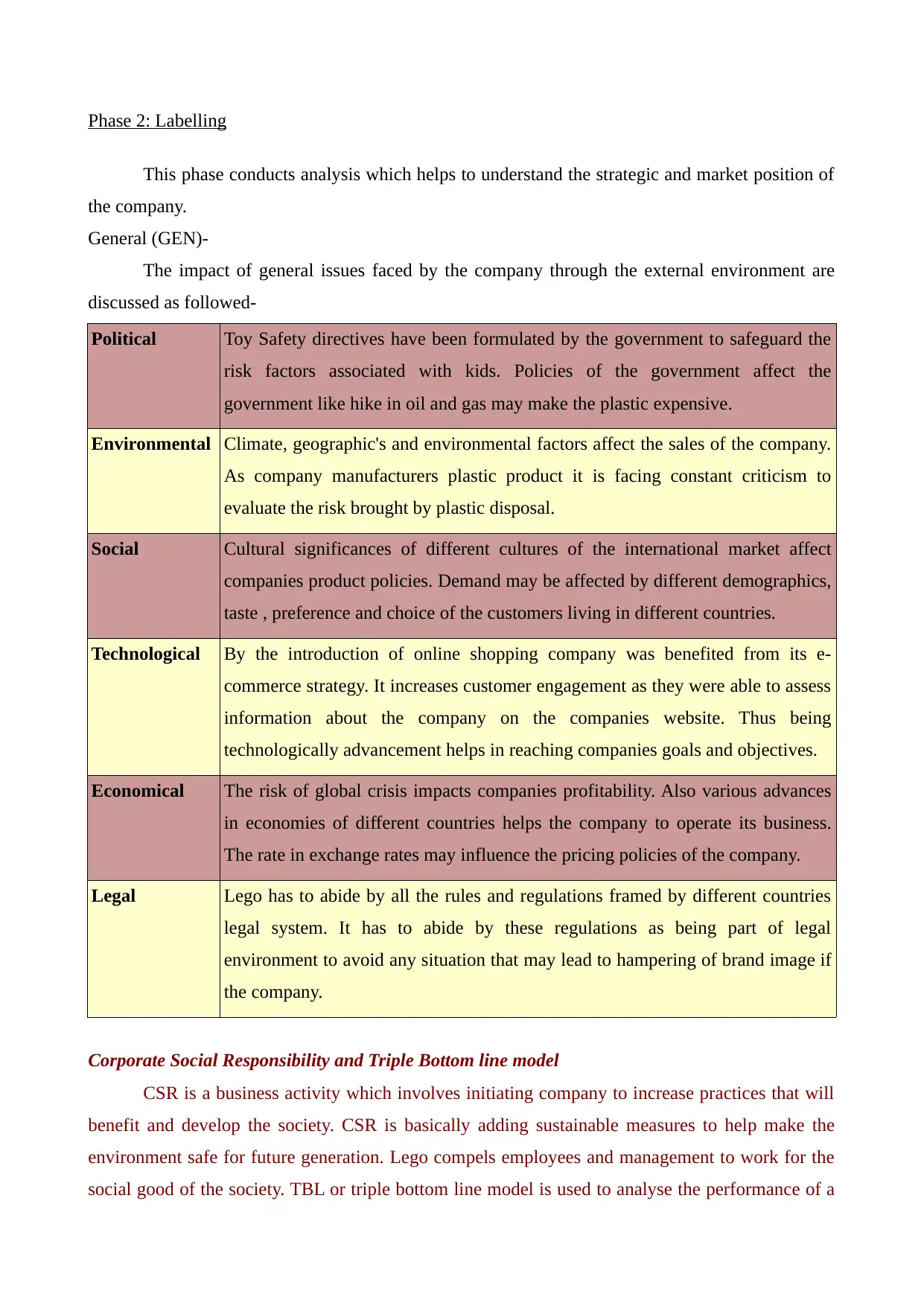
Phase 2: Labelling
This phase conducts analysis which helps to understand the strategic and market position of
the company.
General (GEN)-
The impact of general issues faced by the company through the external environment are
discussed as followed-
Political Toy Safety directives have been formulated by the government to safeguard the
risk factors associated with kids. Policies of the government affect the
government like hike in oil and gas may make the plastic expensive.
Environmental Climate, geographic's and environmental factors affect the sales of the company.
As company manufacturers plastic product it is facing constant criticism to
evaluate the risk brought by plastic disposal.
Social Cultural significances of different cultures of the international market affect
companies product policies. Demand may be affected by different demographics,
taste , preference and choice of the customers living in different countries.
Technological By the introduction of online shopping company was benefited from its e-
commerce strategy. It increases customer engagement as they were able to assess
information about the company on the companies website. Thus being
technologically advancement helps in reaching companies goals and objectives.
Economical The risk of global crisis impacts companies profitability. Also various advances
in economies of different countries helps the company to operate its business.
The rate in exchange rates may influence the pricing policies of the company.
Legal Lego has to abide by all the rules and regulations framed by different countries
legal system. It has to abide by these regulations as being part of legal
environment to avoid any situation that may lead to hampering of brand image if
the company.
Corporate Social Responsibility and Triple Bottom line model
CSR is a business activity which involves initiating company to increase practices that will
benefit and develop the society. CSR is basically adding sustainable measures to help make the
environment safe for future generation. Lego compels employees and management to work for the
social good of the society. TBL or triple bottom line model is used to analyse the performance of a
This phase conducts analysis which helps to understand the strategic and market position of
the company.
General (GEN)-
The impact of general issues faced by the company through the external environment are
discussed as followed-
Political Toy Safety directives have been formulated by the government to safeguard the
risk factors associated with kids. Policies of the government affect the
government like hike in oil and gas may make the plastic expensive.
Environmental Climate, geographic's and environmental factors affect the sales of the company.
As company manufacturers plastic product it is facing constant criticism to
evaluate the risk brought by plastic disposal.
Social Cultural significances of different cultures of the international market affect
companies product policies. Demand may be affected by different demographics,
taste , preference and choice of the customers living in different countries.
Technological By the introduction of online shopping company was benefited from its e-
commerce strategy. It increases customer engagement as they were able to assess
information about the company on the companies website. Thus being
technologically advancement helps in reaching companies goals and objectives.
Economical The risk of global crisis impacts companies profitability. Also various advances
in economies of different countries helps the company to operate its business.
The rate in exchange rates may influence the pricing policies of the company.
Legal Lego has to abide by all the rules and regulations framed by different countries
legal system. It has to abide by these regulations as being part of legal
environment to avoid any situation that may lead to hampering of brand image if
the company.
Corporate Social Responsibility and Triple Bottom line model
CSR is a business activity which involves initiating company to increase practices that will
benefit and develop the society. CSR is basically adding sustainable measures to help make the
environment safe for future generation. Lego compels employees and management to work for the
social good of the society. TBL or triple bottom line model is used to analyse the performance of a
⊘ This is a preview!⊘
Do you want full access?
Subscribe today to unlock all pages.

Trusted by 1+ million students worldwide
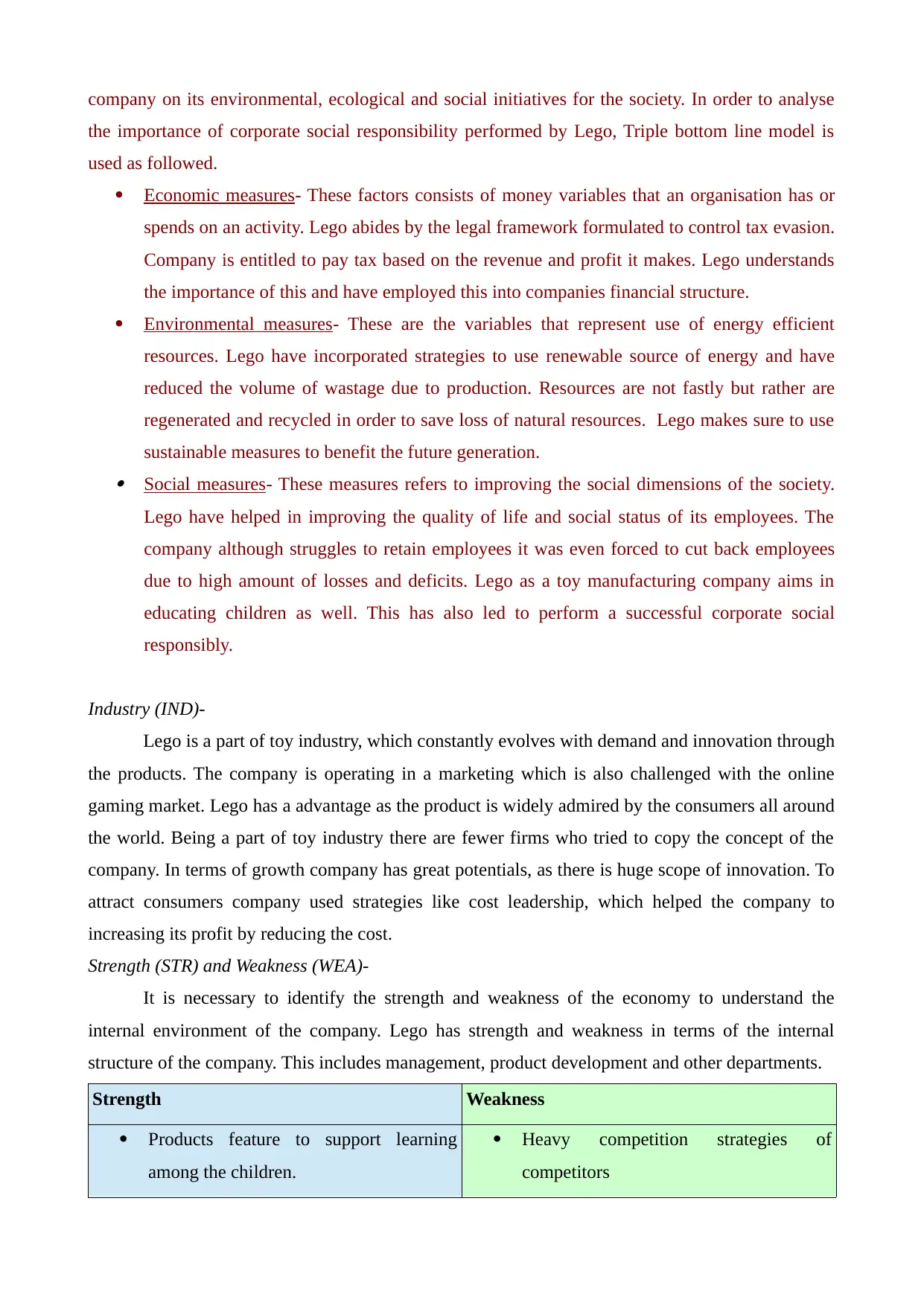
company on its environmental, ecological and social initiatives for the society. In order to analyse
the importance of corporate social responsibility performed by Lego, Triple bottom line model is
used as followed.
Economic measures- These factors consists of money variables that an organisation has or
spends on an activity. Lego abides by the legal framework formulated to control tax evasion.
Company is entitled to pay tax based on the revenue and profit it makes. Lego understands
the importance of this and have employed this into companies financial structure.
Environmental measures- These are the variables that represent use of energy efficient
resources. Lego have incorporated strategies to use renewable source of energy and have
reduced the volume of wastage due to production. Resources are not fastly but rather are
regenerated and recycled in order to save loss of natural resources. Lego makes sure to use
sustainable measures to benefit the future generation. Social measures- These measures refers to improving the social dimensions of the society.
Lego have helped in improving the quality of life and social status of its employees. The
company although struggles to retain employees it was even forced to cut back employees
due to high amount of losses and deficits. Lego as a toy manufacturing company aims in
educating children as well. This has also led to perform a successful corporate social
responsibly.
Industry (IND)-
Lego is a part of toy industry, which constantly evolves with demand and innovation through
the products. The company is operating in a marketing which is also challenged with the online
gaming market. Lego has a advantage as the product is widely admired by the consumers all around
the world. Being a part of toy industry there are fewer firms who tried to copy the concept of the
company. In terms of growth company has great potentials, as there is huge scope of innovation. To
attract consumers company used strategies like cost leadership, which helped the company to
increasing its profit by reducing the cost.
Strength (STR) and Weakness (WEA)-
It is necessary to identify the strength and weakness of the economy to understand the
internal environment of the company. Lego has strength and weakness in terms of the internal
structure of the company. This includes management, product development and other departments.
Strength Weakness
Products feature to support learning
among the children.
Heavy competition strategies of
competitors
the importance of corporate social responsibility performed by Lego, Triple bottom line model is
used as followed.
Economic measures- These factors consists of money variables that an organisation has or
spends on an activity. Lego abides by the legal framework formulated to control tax evasion.
Company is entitled to pay tax based on the revenue and profit it makes. Lego understands
the importance of this and have employed this into companies financial structure.
Environmental measures- These are the variables that represent use of energy efficient
resources. Lego have incorporated strategies to use renewable source of energy and have
reduced the volume of wastage due to production. Resources are not fastly but rather are
regenerated and recycled in order to save loss of natural resources. Lego makes sure to use
sustainable measures to benefit the future generation. Social measures- These measures refers to improving the social dimensions of the society.
Lego have helped in improving the quality of life and social status of its employees. The
company although struggles to retain employees it was even forced to cut back employees
due to high amount of losses and deficits. Lego as a toy manufacturing company aims in
educating children as well. This has also led to perform a successful corporate social
responsibly.
Industry (IND)-
Lego is a part of toy industry, which constantly evolves with demand and innovation through
the products. The company is operating in a marketing which is also challenged with the online
gaming market. Lego has a advantage as the product is widely admired by the consumers all around
the world. Being a part of toy industry there are fewer firms who tried to copy the concept of the
company. In terms of growth company has great potentials, as there is huge scope of innovation. To
attract consumers company used strategies like cost leadership, which helped the company to
increasing its profit by reducing the cost.
Strength (STR) and Weakness (WEA)-
It is necessary to identify the strength and weakness of the economy to understand the
internal environment of the company. Lego has strength and weakness in terms of the internal
structure of the company. This includes management, product development and other departments.
Strength Weakness
Products feature to support learning
among the children.
Heavy competition strategies of
competitors
Paraphrase This Document
Need a fresh take? Get an instant paraphrase of this document with our AI Paraphraser
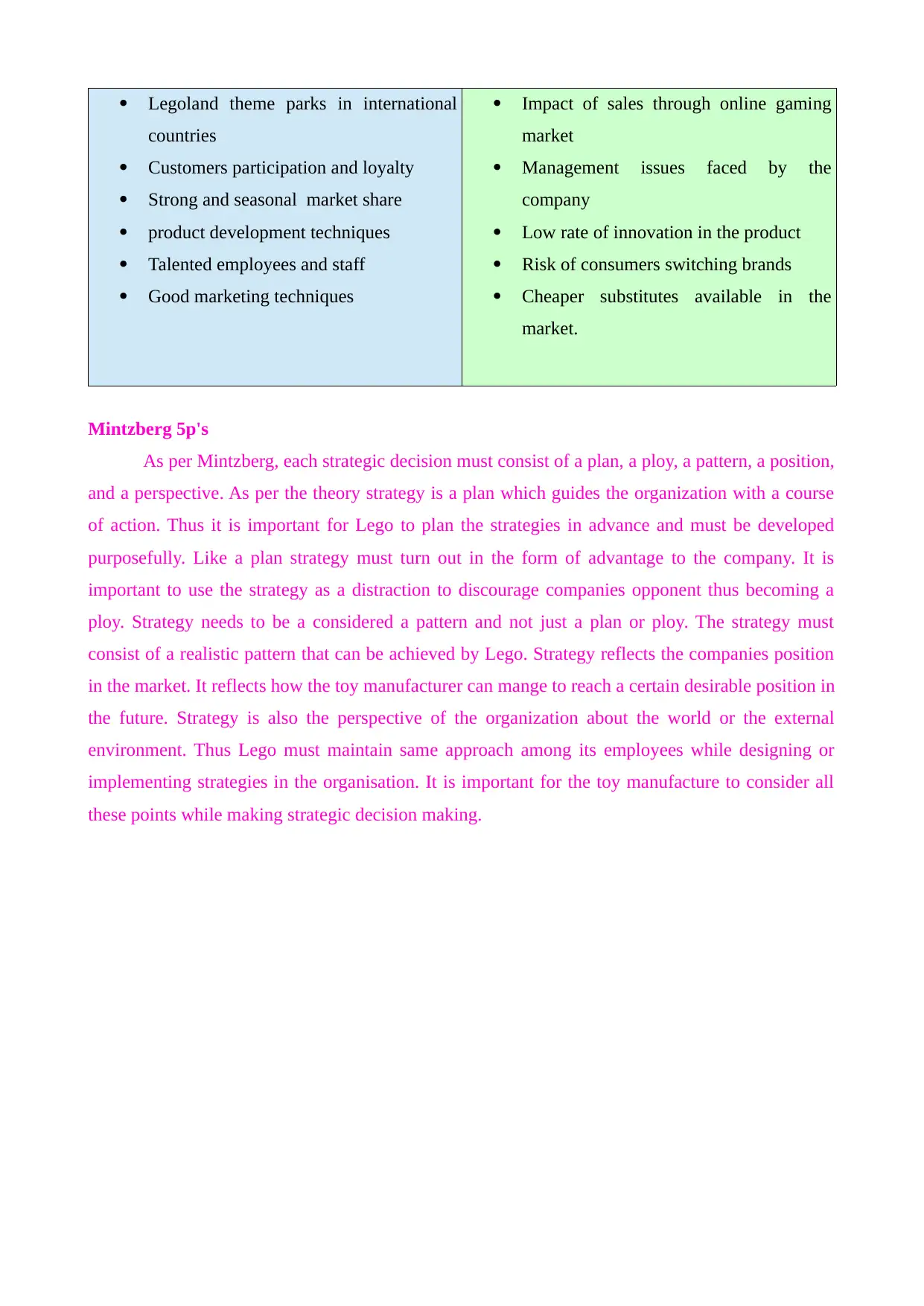
Legoland theme parks in international
countries
Customers participation and loyalty
Strong and seasonal market share
product development techniques
Talented employees and staff
Good marketing techniques
Impact of sales through online gaming
market
Management issues faced by the
company
Low rate of innovation in the product
Risk of consumers switching brands
Cheaper substitutes available in the
market.
Mintzberg 5p's
As per Mintzberg, each strategic decision must consist of a plan, a ploy, a pattern, a position,
and a perspective. As per the theory strategy is a plan which guides the organization with a course
of action. Thus it is important for Lego to plan the strategies in advance and must be developed
purposefully. Like a plan strategy must turn out in the form of advantage to the company. It is
important to use the strategy as a distraction to discourage companies opponent thus becoming a
ploy. Strategy needs to be a considered a pattern and not just a plan or ploy. The strategy must
consist of a realistic pattern that can be achieved by Lego. Strategy reflects the companies position
in the market. It reflects how the toy manufacturer can mange to reach a certain desirable position in
the future. Strategy is also the perspective of the organization about the world or the external
environment. Thus Lego must maintain same approach among its employees while designing or
implementing strategies in the organisation. It is important for the toy manufacture to consider all
these points while making strategic decision making.
countries
Customers participation and loyalty
Strong and seasonal market share
product development techniques
Talented employees and staff
Good marketing techniques
Impact of sales through online gaming
market
Management issues faced by the
company
Low rate of innovation in the product
Risk of consumers switching brands
Cheaper substitutes available in the
market.
Mintzberg 5p's
As per Mintzberg, each strategic decision must consist of a plan, a ploy, a pattern, a position,
and a perspective. As per the theory strategy is a plan which guides the organization with a course
of action. Thus it is important for Lego to plan the strategies in advance and must be developed
purposefully. Like a plan strategy must turn out in the form of advantage to the company. It is
important to use the strategy as a distraction to discourage companies opponent thus becoming a
ploy. Strategy needs to be a considered a pattern and not just a plan or ploy. The strategy must
consist of a realistic pattern that can be achieved by Lego. Strategy reflects the companies position
in the market. It reflects how the toy manufacturer can mange to reach a certain desirable position in
the future. Strategy is also the perspective of the organization about the world or the external
environment. Thus Lego must maintain same approach among its employees while designing or
implementing strategies in the organisation. It is important for the toy manufacture to consider all
these points while making strategic decision making.

Phase 3: Summarising
Porter's Five force model: For summarising the information obtained from the labelling
phase, Porters five force model is taken which is explained below. Supplier Power:The pressure of suppliers on the Lego Company is high as it offers bricks
made-up of plastic which require oil and in case of oil, Lego can not bargain with oil
suppliers. Changes in the prices of oil directly affects the Lego's margins. Buyer Power: The consume pressure on the company is also high as they have bargaining
power . Buyers of Lego are retailers which includes Wal-Mart and Toys “R”Us which also
affects the sales of the firm as in the month of Christmas, they remove the products of Lego
from their shelves. Competitive Rivalry: The competitive rivalry of Lego is less in case of brick stone market.
The company has good brand image and popularity which keeps it at top place in the
priority list as compare to the Best-Lock and Mega Brands. The loyalty of the firm towards
their customers makes them to buy the products of Lego at premium prices. Threats of New Entry: The threats of new entry in toy industry is less for Lego. The variety
of substitutes available in the market and poor economic condition prevents new entries.
Threats of Substitute: The threats of substitutes is very high in toy industry and for Lego
also. As children get bored so quickly and in this situation they move towards the substitutes
which leads to decrease in sales of Lego. The prices of substitutes vary which is also a
reason of switching.
From the above porters five force analysis of Lego, it has been found that there are many
facts which have been identified in phase 2 section. After this assessment, the important facts and
information have enlisted here that are important for this phase.
General Environment (GEN)-
The factors that affects the general environment of Lego are:
Political Factors
Environmental Factors
Social Factors
Technological Factors
Economical Factors Legal Factors
Porter's Five force model: For summarising the information obtained from the labelling
phase, Porters five force model is taken which is explained below. Supplier Power:The pressure of suppliers on the Lego Company is high as it offers bricks
made-up of plastic which require oil and in case of oil, Lego can not bargain with oil
suppliers. Changes in the prices of oil directly affects the Lego's margins. Buyer Power: The consume pressure on the company is also high as they have bargaining
power . Buyers of Lego are retailers which includes Wal-Mart and Toys “R”Us which also
affects the sales of the firm as in the month of Christmas, they remove the products of Lego
from their shelves. Competitive Rivalry: The competitive rivalry of Lego is less in case of brick stone market.
The company has good brand image and popularity which keeps it at top place in the
priority list as compare to the Best-Lock and Mega Brands. The loyalty of the firm towards
their customers makes them to buy the products of Lego at premium prices. Threats of New Entry: The threats of new entry in toy industry is less for Lego. The variety
of substitutes available in the market and poor economic condition prevents new entries.
Threats of Substitute: The threats of substitutes is very high in toy industry and for Lego
also. As children get bored so quickly and in this situation they move towards the substitutes
which leads to decrease in sales of Lego. The prices of substitutes vary which is also a
reason of switching.
From the above porters five force analysis of Lego, it has been found that there are many
facts which have been identified in phase 2 section. After this assessment, the important facts and
information have enlisted here that are important for this phase.
General Environment (GEN)-
The factors that affects the general environment of Lego are:
Political Factors
Environmental Factors
Social Factors
Technological Factors
Economical Factors Legal Factors
⊘ This is a preview!⊘
Do you want full access?
Subscribe today to unlock all pages.

Trusted by 1+ million students worldwide
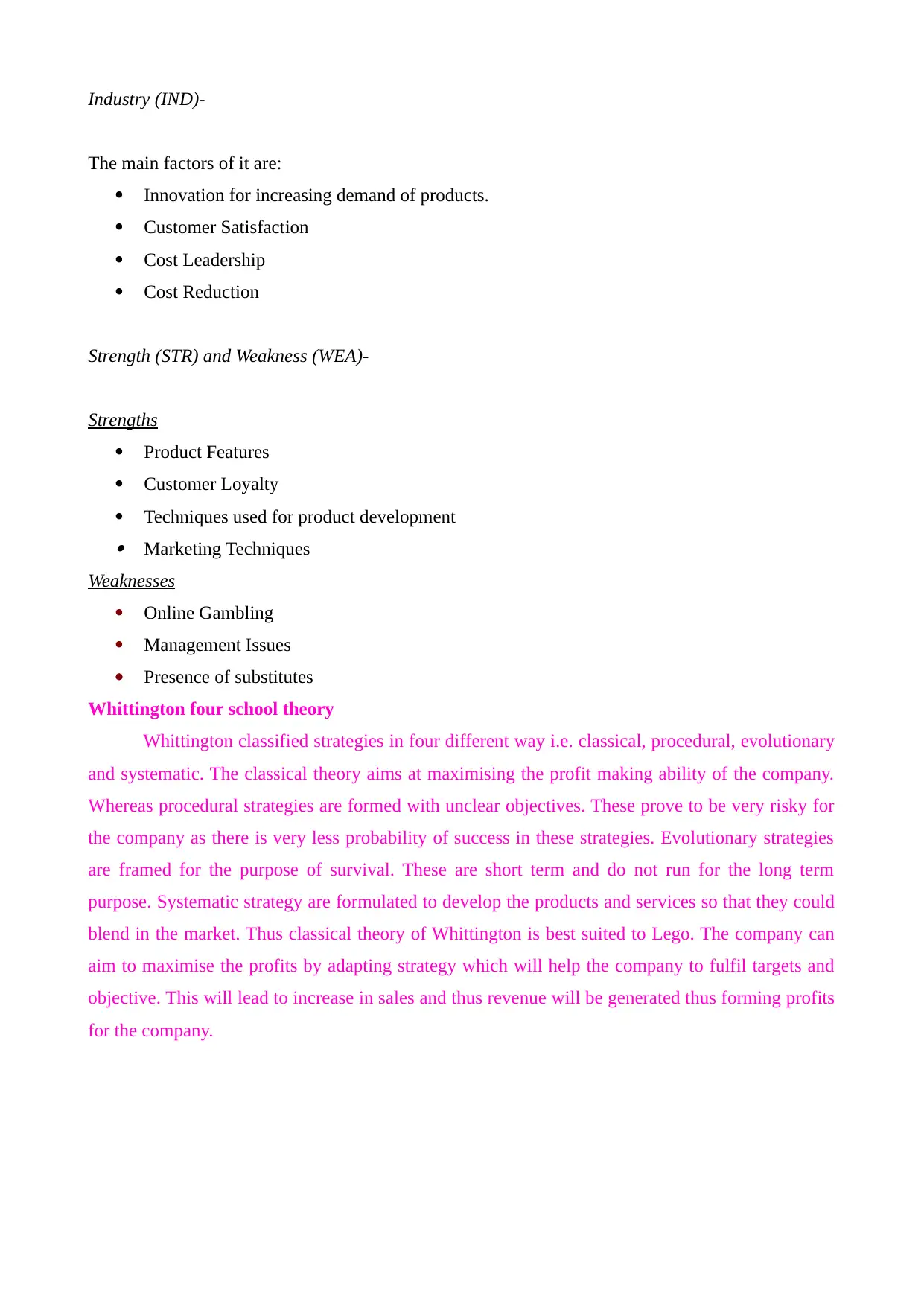
Industry (IND)-
The main factors of it are:
Innovation for increasing demand of products.
Customer Satisfaction
Cost Leadership
Cost Reduction
Strength (STR) and Weakness (WEA)-
Strengths
Product Features
Customer Loyalty
Techniques used for product development Marketing Techniques
Weaknesses
Online Gambling
Management Issues
Presence of substitutes
Whittington four school theory
Whittington classified strategies in four different way i.e. classical, procedural, evolutionary
and systematic. The classical theory aims at maximising the profit making ability of the company.
Whereas procedural strategies are formed with unclear objectives. These prove to be very risky for
the company as there is very less probability of success in these strategies. Evolutionary strategies
are framed for the purpose of survival. These are short term and do not run for the long term
purpose. Systematic strategy are formulated to develop the products and services so that they could
blend in the market. Thus classical theory of Whittington is best suited to Lego. The company can
aim to maximise the profits by adapting strategy which will help the company to fulfil targets and
objective. This will lead to increase in sales and thus revenue will be generated thus forming profits
for the company.
The main factors of it are:
Innovation for increasing demand of products.
Customer Satisfaction
Cost Leadership
Cost Reduction
Strength (STR) and Weakness (WEA)-
Strengths
Product Features
Customer Loyalty
Techniques used for product development Marketing Techniques
Weaknesses
Online Gambling
Management Issues
Presence of substitutes
Whittington four school theory
Whittington classified strategies in four different way i.e. classical, procedural, evolutionary
and systematic. The classical theory aims at maximising the profit making ability of the company.
Whereas procedural strategies are formed with unclear objectives. These prove to be very risky for
the company as there is very less probability of success in these strategies. Evolutionary strategies
are framed for the purpose of survival. These are short term and do not run for the long term
purpose. Systematic strategy are formulated to develop the products and services so that they could
blend in the market. Thus classical theory of Whittington is best suited to Lego. The company can
aim to maximise the profits by adapting strategy which will help the company to fulfil targets and
objective. This will lead to increase in sales and thus revenue will be generated thus forming profits
for the company.
Paraphrase This Document
Need a fresh take? Get an instant paraphrase of this document with our AI Paraphraser
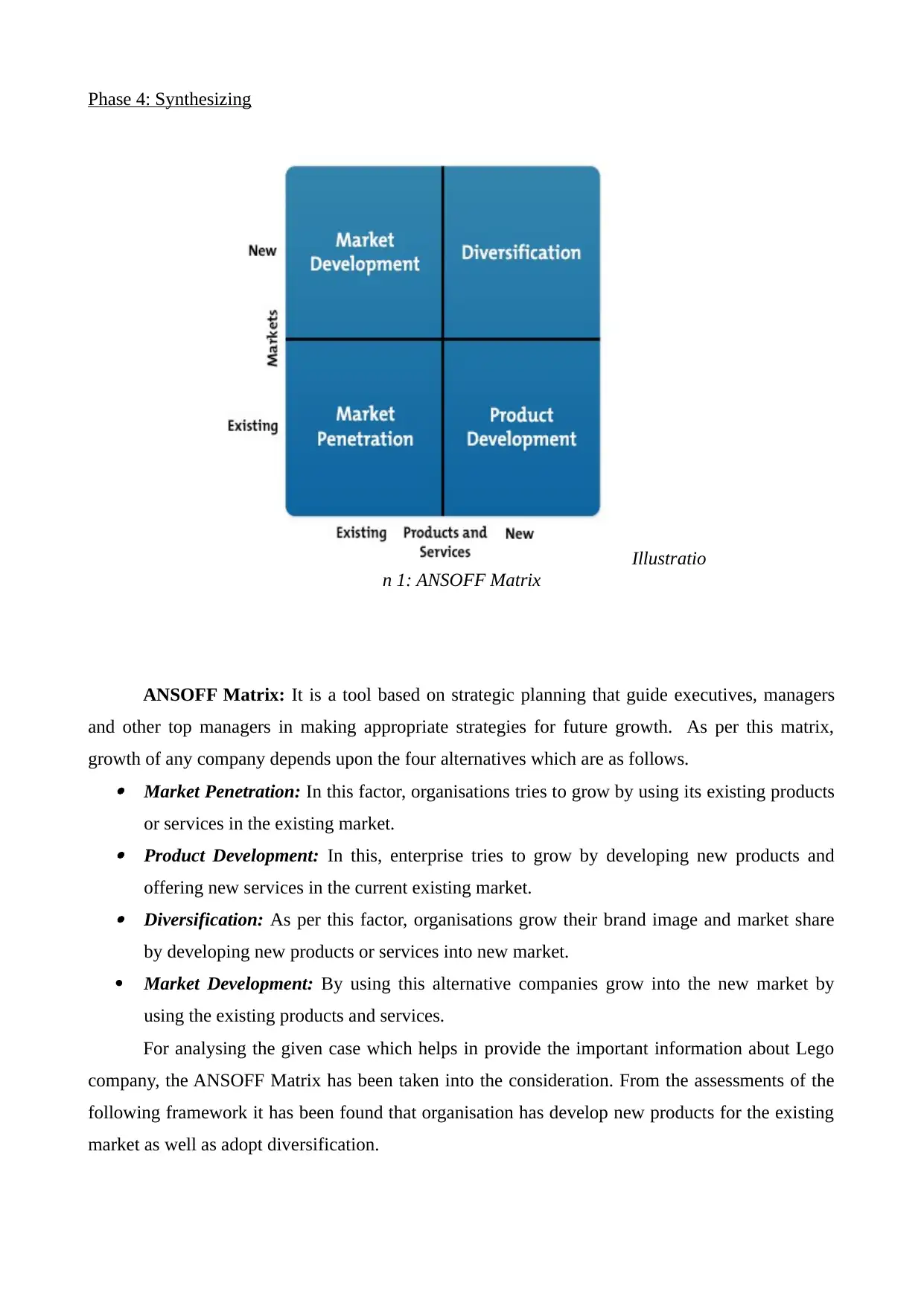
Phase 4: Synthesizing
ANSOFF Matrix: It is a tool based on strategic planning that guide executives, managers
and other top managers in making appropriate strategies for future growth. As per this matrix,
growth of any company depends upon the four alternatives which are as follows. Market Penetration: In this factor, organisations tries to grow by using its existing products
or services in the existing market. Product Development: In this, enterprise tries to grow by developing new products and
offering new services in the current existing market. Diversification: As per this factor, organisations grow their brand image and market share
by developing new products or services into new market.
Market Development: By using this alternative companies grow into the new market by
using the existing products and services.
For analysing the given case which helps in provide the important information about Lego
company, the ANSOFF Matrix has been taken into the consideration. From the assessments of the
following framework it has been found that organisation has develop new products for the existing
market as well as adopt diversification.
Illustratio
n 1: ANSOFF Matrix
ANSOFF Matrix: It is a tool based on strategic planning that guide executives, managers
and other top managers in making appropriate strategies for future growth. As per this matrix,
growth of any company depends upon the four alternatives which are as follows. Market Penetration: In this factor, organisations tries to grow by using its existing products
or services in the existing market. Product Development: In this, enterprise tries to grow by developing new products and
offering new services in the current existing market. Diversification: As per this factor, organisations grow their brand image and market share
by developing new products or services into new market.
Market Development: By using this alternative companies grow into the new market by
using the existing products and services.
For analysing the given case which helps in provide the important information about Lego
company, the ANSOFF Matrix has been taken into the consideration. From the assessments of the
following framework it has been found that organisation has develop new products for the existing
market as well as adopt diversification.
Illustratio
n 1: ANSOFF Matrix
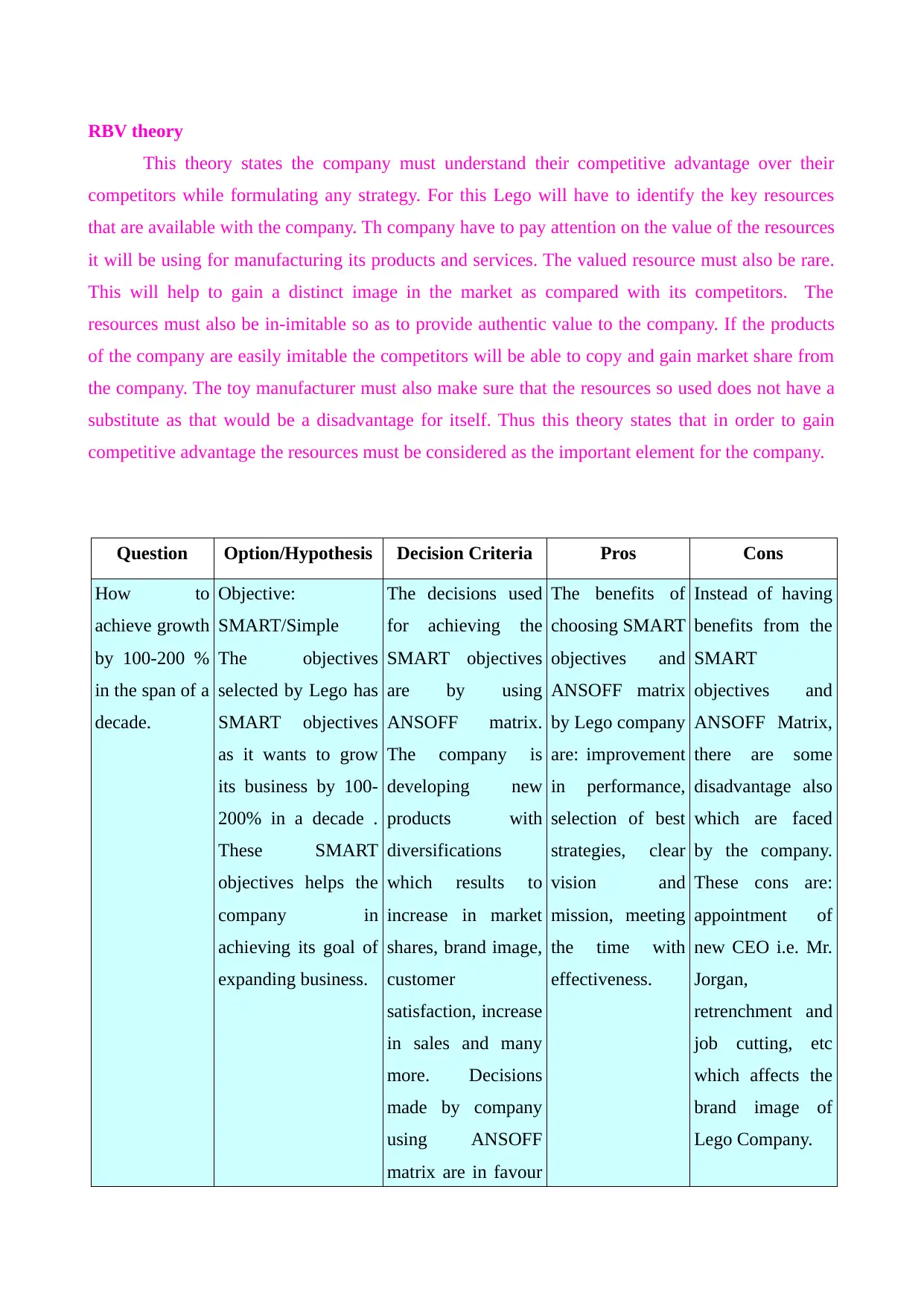
RBV theory
This theory states the company must understand their competitive advantage over their
competitors while formulating any strategy. For this Lego will have to identify the key resources
that are available with the company. Th company have to pay attention on the value of the resources
it will be using for manufacturing its products and services. The valued resource must also be rare.
This will help to gain a distinct image in the market as compared with its competitors. The
resources must also be in-imitable so as to provide authentic value to the company. If the products
of the company are easily imitable the competitors will be able to copy and gain market share from
the company. The toy manufacturer must also make sure that the resources so used does not have a
substitute as that would be a disadvantage for itself. Thus this theory states that in order to gain
competitive advantage the resources must be considered as the important element for the company.
Question Option/Hypothesis Decision Criteria Pros Cons
How to
achieve growth
by 100-200 %
in the span of a
decade.
Objective:
SMART/Simple
The objectives
selected by Lego has
SMART objectives
as it wants to grow
its business by 100-
200% in a decade .
These SMART
objectives helps the
company in
achieving its goal of
expanding business.
The decisions used
for achieving the
SMART objectives
are by using
ANSOFF matrix.
The company is
developing new
products with
diversifications
which results to
increase in market
shares, brand image,
customer
satisfaction, increase
in sales and many
more. Decisions
made by company
using ANSOFF
matrix are in favour
The benefits of
choosing SMART
objectives and
ANSOFF matrix
by Lego company
are: improvement
in performance,
selection of best
strategies, clear
vision and
mission, meeting
the time with
effectiveness.
Instead of having
benefits from the
SMART
objectives and
ANSOFF Matrix,
there are some
disadvantage also
which are faced
by the company.
These cons are:
appointment of
new CEO i.e. Mr.
Jorgan,
retrenchment and
job cutting, etc
which affects the
brand image of
Lego Company.
This theory states the company must understand their competitive advantage over their
competitors while formulating any strategy. For this Lego will have to identify the key resources
that are available with the company. Th company have to pay attention on the value of the resources
it will be using for manufacturing its products and services. The valued resource must also be rare.
This will help to gain a distinct image in the market as compared with its competitors. The
resources must also be in-imitable so as to provide authentic value to the company. If the products
of the company are easily imitable the competitors will be able to copy and gain market share from
the company. The toy manufacturer must also make sure that the resources so used does not have a
substitute as that would be a disadvantage for itself. Thus this theory states that in order to gain
competitive advantage the resources must be considered as the important element for the company.
Question Option/Hypothesis Decision Criteria Pros Cons
How to
achieve growth
by 100-200 %
in the span of a
decade.
Objective:
SMART/Simple
The objectives
selected by Lego has
SMART objectives
as it wants to grow
its business by 100-
200% in a decade .
These SMART
objectives helps the
company in
achieving its goal of
expanding business.
The decisions used
for achieving the
SMART objectives
are by using
ANSOFF matrix.
The company is
developing new
products with
diversifications
which results to
increase in market
shares, brand image,
customer
satisfaction, increase
in sales and many
more. Decisions
made by company
using ANSOFF
matrix are in favour
The benefits of
choosing SMART
objectives and
ANSOFF matrix
by Lego company
are: improvement
in performance,
selection of best
strategies, clear
vision and
mission, meeting
the time with
effectiveness.
Instead of having
benefits from the
SMART
objectives and
ANSOFF Matrix,
there are some
disadvantage also
which are faced
by the company.
These cons are:
appointment of
new CEO i.e. Mr.
Jorgan,
retrenchment and
job cutting, etc
which affects the
brand image of
Lego Company.
⊘ This is a preview!⊘
Do you want full access?
Subscribe today to unlock all pages.

Trusted by 1+ million students worldwide
1 out of 16
Your All-in-One AI-Powered Toolkit for Academic Success.
+13062052269
info@desklib.com
Available 24*7 on WhatsApp / Email
![[object Object]](/_next/static/media/star-bottom.7253800d.svg)
Unlock your academic potential
Copyright © 2020–2025 A2Z Services. All Rights Reserved. Developed and managed by ZUCOL.

